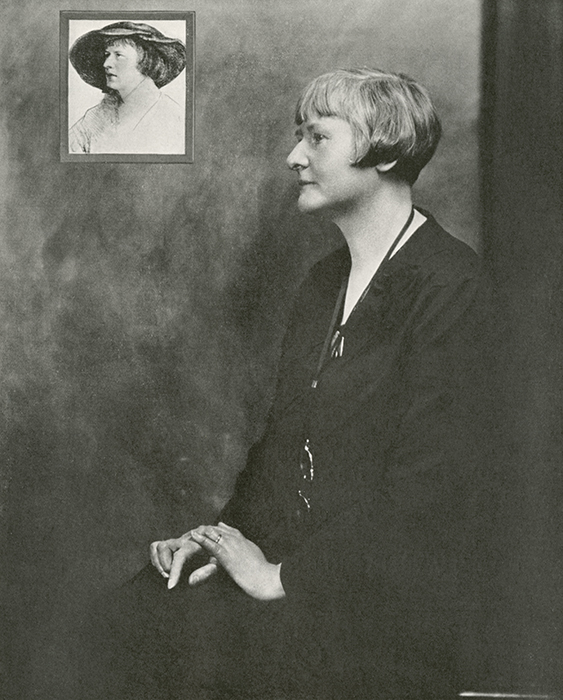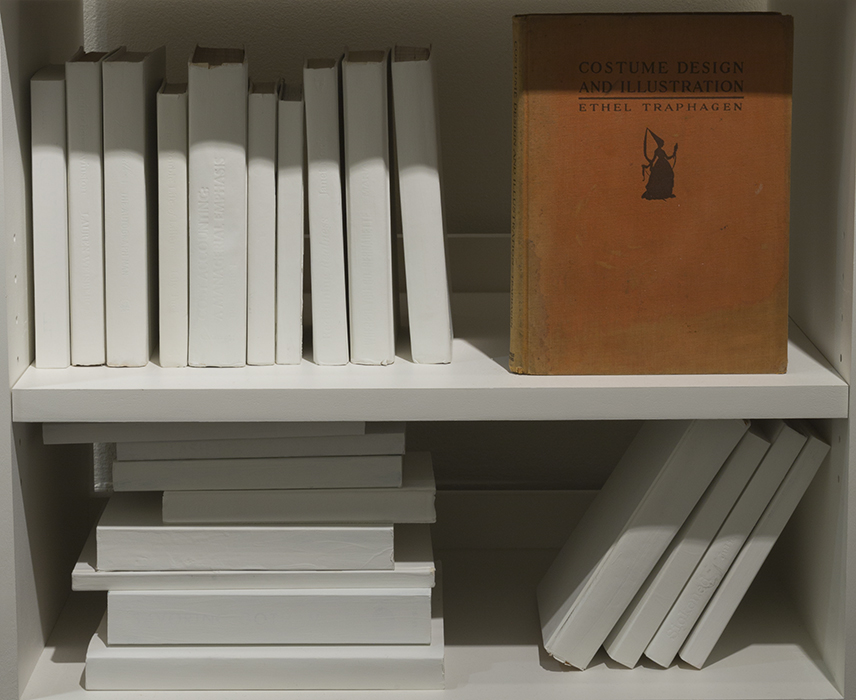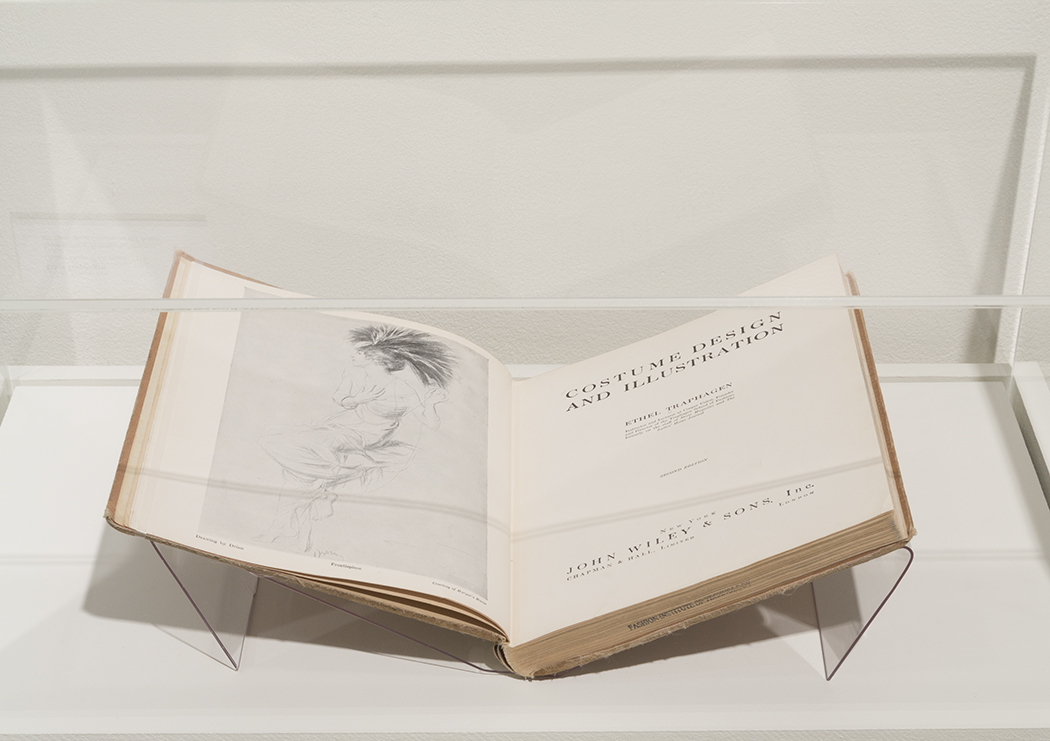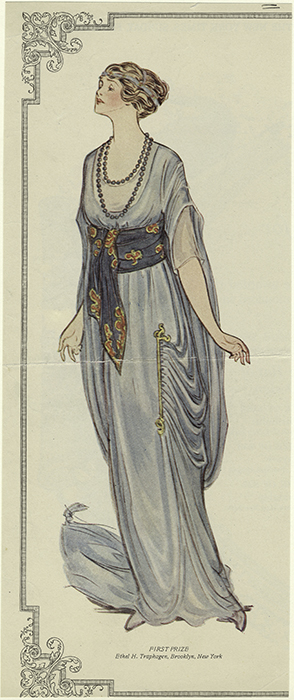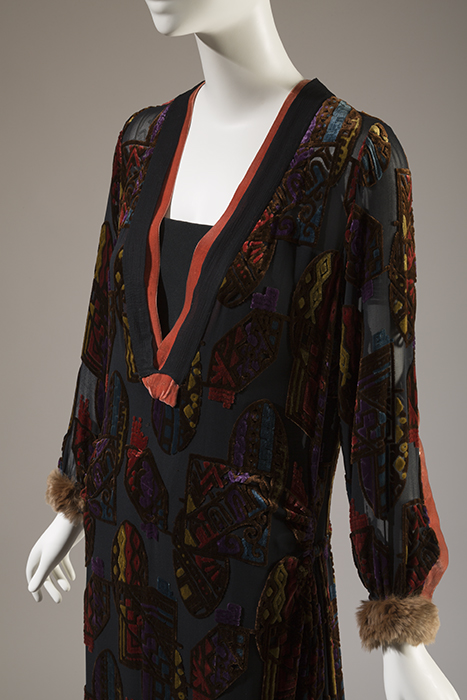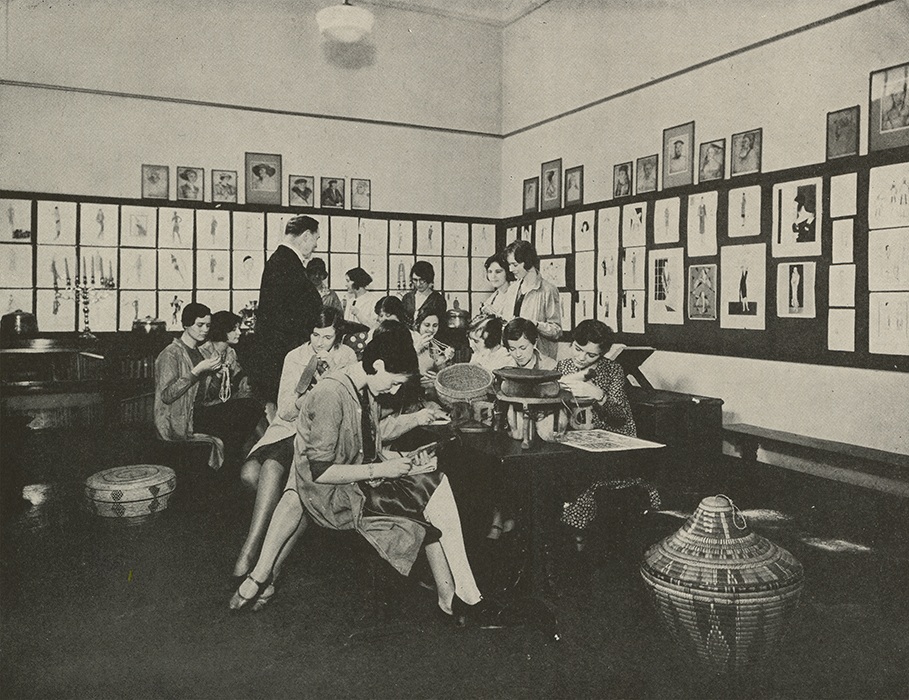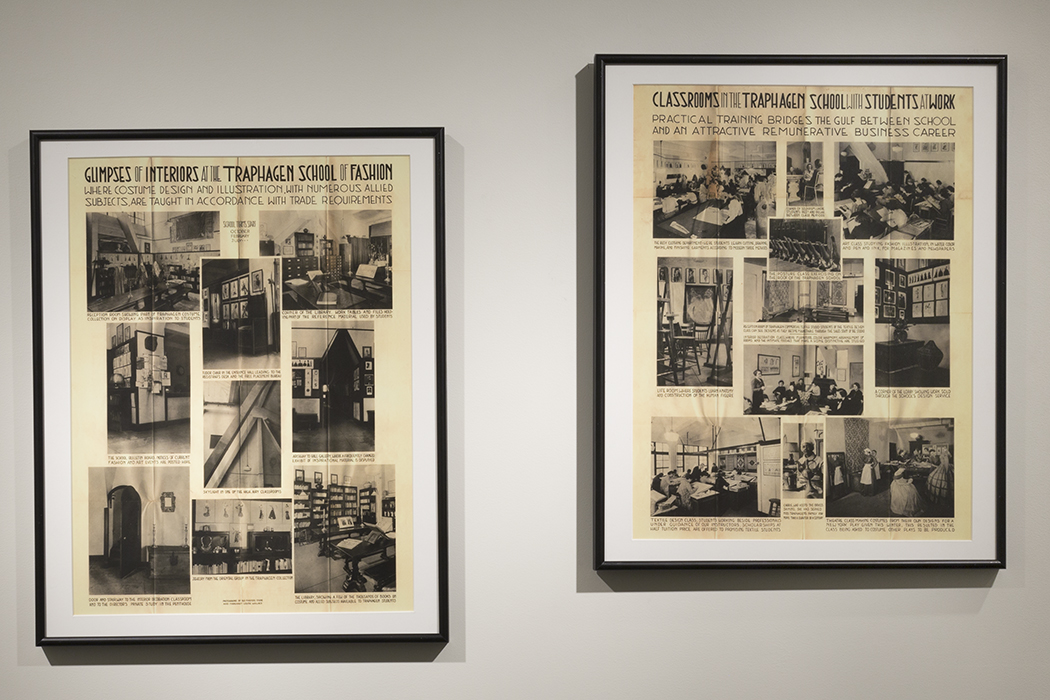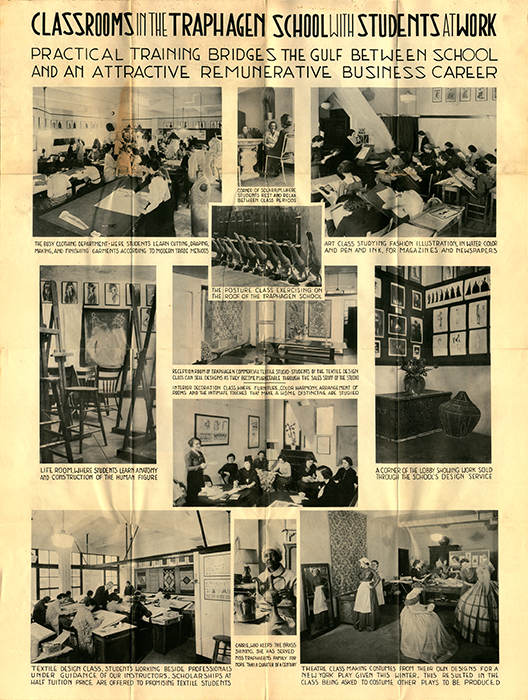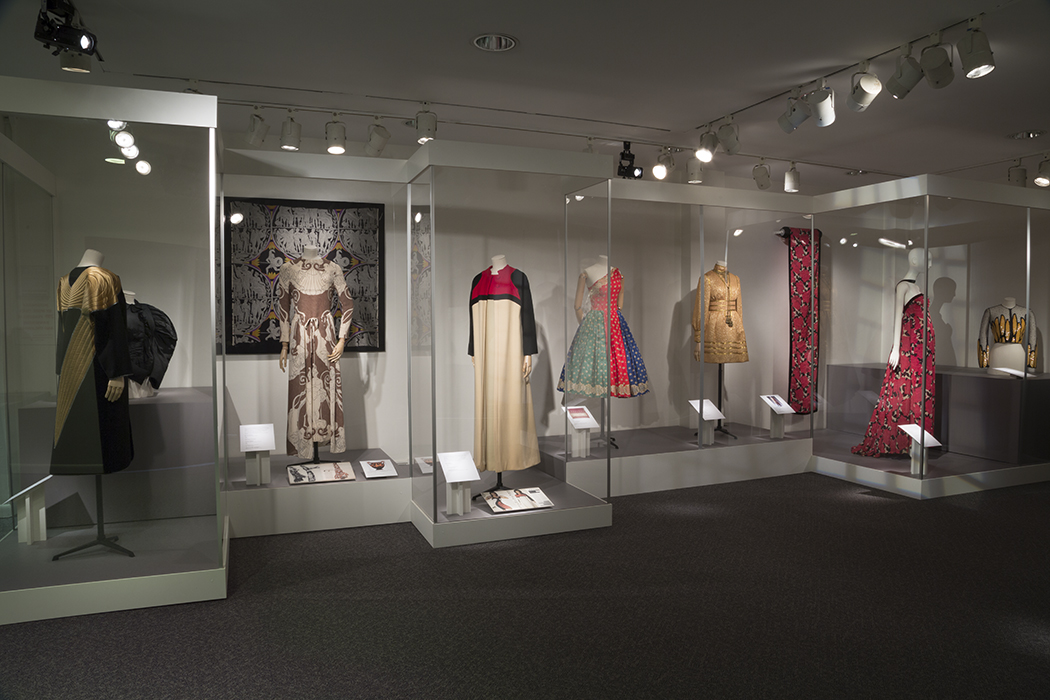Ethel Traphagen
-
Image InfoClose
Portrait of Ethel Traphagen
In this portrait, Ethel Traphagen (1882-1963) sits before an illustration of herself that hung in her school’s library. Traphagen worked in the fashion industry as an illustrator, writer, and designer and was one of the first teachers of fashion design in New York City. She taught for twenty years before founding The Traphagen School of Fashion as an early institution dedicated solely to educating fashion industry professionals.
Portrait of Ethel Traphagen, photographer unknown, from The Silhouette, The Traphagen School of Fashion, 1933.
-
Image InfoClose
Cover of Costume Design and Illustration
-
Image InfoClose
Costume Design and Illustration
In Costume Design and Illustration by Ethel Traphagen, first published in 1918, sketching is emphasized as a foundational design skill. The Traphagen School was renowned for producing successful fashion illustrators. This seminal text in fashion education has been reprinted continuously, most recently in 2010.
-
Image InfoClose
Ethel Traphagen’s winning “Whistler Gown”
In 1913, Ethel Traphagen won first prize in a nationwide design contest organized by the Ladies’ Home Journal. She adapted the colors and forms in Whistler’s painting Nocturne: Blue and Gold, Old Battersea Bridge into her design. Her win catapulted her to the forefront of the American design movement.
Ethel Traphagen’s winning “Whistler Gown”. Reproduction from New York Times, February 23, 1913
The Traphagen School
-
Image InfoClose
Zanbaraza print dress
Students drew inspiration from artifacts that Ethel Traphagen collected in Nairobi, Kenya, in 1928 to create the shield motif textile for this “Zanbaraza” dress. During the early 20th century, Euro-American artists within the Modern Primitivism movement took a colonialist view of African art and craft as untouched by civilization, making it an attractive new source of inspiration. One way these ideas trickled down to the wider public was through the practice of design-by-adaptation in fashion.
Zanbaraza print dress, c. 1929, Gift of June Mayper.
-
Image InfoClose
Students working on the Zanbaraza dress
Traphagen students working on Zanbaraza project in 1929, Costume Design & Illustration, 1932, Reproduction.
-
Image InfoClose
The Traphagen School Posters
The Traphagen School produced these promotional posters to attract prospective students. One poster features students at work, while the other showcases the school’s study spaces and collections of artifacts, books, and fashion plates. The classrooms were filled with these objects to provide students with design inspiration.
“Glimpses of Interiors at The Traphagen School of Fashion” & “Classrooms in the Traphagen School” Poster front and back, 1941, Reproduction, Loan from Emily Nissen.
-
Image InfoClose
“Classrooms in the Traphagen School”
“Classrooms in the Traphagen School”. Poster front and back, 1941. Reproduction. Loan from Emily Nissen.
Alumni Highlights
-
Image InfoClose
Traphagen_28-cropped-v2
Geoffrey Beene often experimented by juxtaposing two distinct materials in one garment. The transparent fabric and applied sequins of this bodice allude to the monarch butterfly. The orange and black sequins also weigh down the gossamer fabric, referencing the fragility of butterfly wings.
Geoffrey Beene evening jacket, nylon, winter 1991-1992.
-
Image InfoClose
Installation View
-
Image InfoClose
Carolyn Schnurer dress
This design by Carolyn Schnurer is based on traditional Indian clothing. Schnurer, known for traveling the world for inspiration, used a printed paisley textile in her adaptation of the sari.
Carolyn Schnurer, cotton one shoulder dress, 1952, Gift of Mitch Rein.
-
Image InfoClose
James Galanos dress
This ensemble from James Galanos’s collection of spring/summer 1970 features warrior and lion motifs inspired by ancient Greek pottery. The accompanying fabric is a sample by textile designer Tzaims Luksus from the same collection. It also draws inspiration from classical Greek art and artifacts. Galanos, a first-generation American, practiced design-by-adaptation using his own Greek heritage.
James Galanos, Textile Designer: Tzaims Luksus, evening dress and overskirt, 1970 Gift of Maurice S. Polkowitz.
-
Image InfoClose
John Kloss dress and coat
The geometric piecework and color-blocking of this ensemble are reminiscent of Hard-Edge Abstraction, characterized by harshly juxataposed colors. John Kloss, who shared a studio with contemporary artist Robert Indiana early on in his career, often drew inspiration from various aspects of modern art, such as colors, forms, and techniques.
John Kloss dress and coat, wool, 1966, Gift of Elaine A. Flug.
-
Image InfoClose
Geoffrey Beene dress
Beene transformed the silhouette and gold braid details of a traditional man’s sherwani into a mini-dress.
Geoffrey Beene dress, lurex, brass filigree 1969, Gift of Jane L. Rodgers.
-
Image InfoClose
Geoffrey Beene ensemble
This 19th-century jacket was donated to MFIT by Geoffrey Beene. It likely came from his company’s reference collection — similar to Traphagen’s own study collection.
Geoffrey Beene, quilted silk and wool ensemble, Fall 1983, Gift of Sally Kahan.
-
Image InfoClose
Grenelle-Estevez evening dress
Luis Estévez chose to use a lightweight cotton fabric to create this evening gown. A silk fabric, such as a full-bodied satin, would have been the more conventional choice for evening wear at the time. Estévez also used nature as his inspiration for this gown, abstracting the image of a rose.
Grenelle-Estevez, evening dress, c. 1957, Gift of Sylvia Levine.
-
Image InfoClose
Anne Klein ensemble
The lacing detail on the skirt of this ensemble is hidden when paired with its matching tunic, but when the skirt is worn separately, the lacing becomes a unique design element. Klein’s fashionable separates offered women an affordable way to create their own style by mixing various versatile pieces.
Anne Klein, white leather tunic and skirt set, 1968, Gift of Dorothy Pollack.
Battle of Versailles
The Battle of Versailles was a charity fashion show that featured five New York ready- to-wear designers competing against five Parisian couturiers. Following the American presentation, guests celebrated by throwing their programs into the air. Their success was a triumph of the American design movement’s — and Ethel Traphagen’s — efforts to distinguish American ready-to-wear from French fashion.
-
Image InfoClose
Stephen Burrows gown
During his Versailles presentation, Stephen Burrows showed this gown featuring his signature “lettuce” edge hem. His colorful collection highlighted the innovation and creativity of New York style. An alumnus of the Fashion Institute of Technology, Burrows represented a new generation of designers emerging from New York City fashion institutions that embraced the legacy of The Traphagen School.
Bill Cunningham, Stephen Burrows gown worn by model Karen Bjornson at the Battle of Versailles, Photograph, 1973.
Nancy North Photographs and Sketches, 1973 Fashion Institute of Technology/SUNY FIT Library Special Collections and FIT Archives
-
Image InfoClose
Battle of Versailles Program
The Battle of Versailles was a charity fashion show that featured five New York ready- to-wear designers competing against five Parisian couturiers. Following the American presentation, guests celebrated by throwing their programs into the air. Their success was a triumph of the American design movement’s — and Ethel Traphagen’s — efforts to distinguish American ready-to-wear from French fashion.
Battle of Versailles Program, Eleanor Lambert Collection, 1973, Fashion Institute of Technology/SUNY FIT Library Special Collections and FIT Archives.







